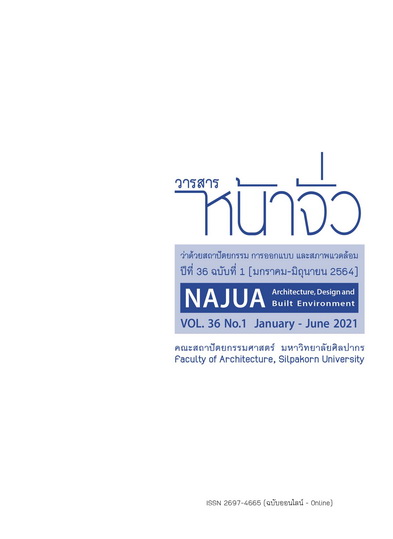Encasement of the Buddhist Monuments at Bagan, Myanmar
Keywords:
Encasement, Bagan, Myanmar, Architecture, Buddhist Monument, EpigraphicAbstract
Among the encased Buddhist monuments in Myanmar, the most have been documented at Bagan, located in the central part of the country. The types of encasement are the encased stupa, the encased temple, the encased group of stupas, the moathtaw stupa, and the encased image. Archaeological evidence indicates that the development of this practice from circa 900-1300 CE can generally be seen in the existing chronological and spatial developments of Bagan.
This idea originated from ancient India and some encased Buddhist monuments built in successive periods can be found in India. The practice of encased monuments was distributed in various parts of Myanmar. This was a deliberate and religious practice, not merely a way for a donor to conserve a damaged monument. The objectives of this article are to understand their concepts and technological developments, to realize the ritual customs and beliefs of the encasement. Sources include the strong epigraphic records such as stone inscriptions, ink inscriptions, Myanmar chronicles and history of Buddhist monuments regarding the encasement.
This paper combines archaeological study, architectural and art historical study, epigraphic records regarding the encasement and anthropological approaches. Most of the style of the encasement show varied influences of India, Sri Lanka, Pyu, and Mon areas. Some of them are Northern Indian styles while some are southern Indian styles. Some of them are very similar to Sri Lanka styles while some are very similar to Pyu and Mon styles.
References
Aung Kyaing, Minbu. (1984). Art and Architecture of Bagan Period. (In Myanmar). Yangon: Sarpay Beikhman Press.
Aung Kyaing, Minbu. (1992). History of Lokananda Stupa. (In Myanmar). Yangon: Thu Dhamma waddi Press.
Aung Kyaing, Minbu. (2002). The Artistic Works of Shwe Zi Gon. (In Myanmar). Yangon: Sarpay Beikhman Press.
Aung Kyaing, Minbu. (2007). Guide to Bagan Monuments. Yangon: Htet Wai Yan Literature.
Aung Kyaing, Minbu. (2017). Tamote Shwegugyi Temple. (In Myanmar). Yangon: Mudita Press.
Aung Thaw, U.(1972). Historical Sites in Burma. Yangon: Archaeology Department, Ministry of Culture.
Ba Han, Dr. (1995). The University English-Myanmar Dictionary, Vol-(1 to 3), Yangon: Win Literature.
Bo Kay, U (1974). Archaeological guide to Pagan and its ancient monuments. Unpublished English manuscript, Bagan: Archaeology Department Library.
Bo Kay, U (1981). Guide to Bagan Research. (In Myanmar). Yangon: Sapay Beikhman Press.
Byrne, Denis. (1995). “Buddhist Stupa and Thai Social Practice,” World Archaeology, Vol.27, No.2, P 266-281, Buddhist Archaeology, Taylor & Francis, Ltd.
Cooler, Richard M. (2002). The Art and Culture of Burma. Center for Southeast Asian Studies, Northern Illinois University.
DANM (2016). Inventory of Monuments at Halin. (In Myanmar), Nay Pyi Taw: Department of Archaeology and National Museum.
DANM (2015). Inventory of Monuments at Pakhangyi Region. (In Myanmar), Nay Pyi Taw: Department of Archaeology and National Museum.
Geiger, Wilhelm (1912). The Mahavamsa or The Great Chronicle of Ceylon. Oxford University Press.
Glimpses of Glorious Bagan, (1986). Yangon: Universities Historical Research Centre, The Universities Press.
Hudson, Bob. (2004). “The Origins of Bagan,” The Archaeological Landscape of Upper Burma to AD 1300, Ph.D. Dissertation, Sydney: University of Sydney.
Khon Rama. (2000). History of Mwedaw Kakku Pagoda. (In Myanmar). Taunggyi: Mwedaw Kakku Pagoda Trustee.
Luce, G. H. (1969). Old Burma Early Pagan, Vol 1-3. Published for Artibus Asiae and the Institute of Fine Arts, New York University.
Ministry of Religious Affairs. (1996). A Dictionary of Buddhist Terms. Yangon: Ministry of Religious Affairs.
Mitra, Debala. (1971). Buddhist Monuments. Calcutta: The India Press Pvt. Ld.
Moe (Kyaukse). (2009). Shinpin Shwe Sutthwa Pagoda. (In Myanmar). Nyaung Shwe Village, Kyaukse Township, Mandalay Region.
Mya Kyaw, U. (2009). Dictionary of the stone inscription in Bagan period. (In Myanmar), Yangon: Pyi Zone Press.
Myat Min Hlaing, U. (2003). Ancient Pagodas in Myanmar. (In Myanmar), Yangon: The New Light of Myanmar.
Myo Nyunt Aung, U. (2008). The Encased Buddhist Stupas and Temples in Bagan. (In Myanmar), (Unpublished Paper). Paper Reading Session of the Ministry of Culture. Nay Pyi Taw. the Ministry of Culture.
Myo Nyunt Aung, U, (2015). The Encased Buddhist Monuments and Buddha Statues in Myanmar. (Online Burma Library), International Conference for Burma Studies. Bangkok.
Nan Oo Stupa Stone Inscription. (2007). Nan Oo Stupa, Kyaukse Township, Mandalay Region.
Nyein Maung, U. (1972). Ancient Myanmar Stone Inscriptions (Volume-1). Yangon: Department of Archaeology.
Nyein Maung, U. (1982). Ancient Myanmar Stone Inscriptions (Volume-2). Yangon: Department of Archaeology.
Nyein Maung, U. (1983). Ancient Myanmar Stone Inscriptions (Volume-3). Yangon: Department of Archaeology.
Nyein Maung, U. (1998). Ancient Myanmar Stone Inscriptions (Volume-4). Yangon: Department of Archaeology.
Nyein Maung, U. (1998). Ancient Myanmar Stone Inscriptions (Volume-5). Yangon: Department of Archaeology.
Nyein Maung, U. (2013). Ancient Myanmar Stone Inscriptions (Volume-6). Yangon: Department of Archaeology and National Museum.
Pe Maung Tin and Luce G.H. (1960). The Glass Palace Chronicle (tr). Rangoon: Burma Research Society.
Pierre Pichard (1992-2001). Inventory of Monuments at Pagan, Vol. 1 - 8. Paris: UNESCO.
Shwe Indein Temple Stone Inscription. (2001). Shwe Indein Temple, Nyaung Shwe Township, Southern Shan State.
Shwezigon Stupa Stone Inscription. (2007). Shwezigon Stupa, Ancient City of Makkhaya, Sint Kaing Township, Mandalay Region.
Soni, Sujata, (1991). Evolution of Stupas in Burma,” Pagan Period: 11th to 13th centuries AD, Delhi: Motilal Banarsidass Publishers.
Than Tun, Dr. (1978). “History of Buddhism in Burma, 1000-1300”, Journal of the Burma Research Society, LXI, 1-2.
Than Tun, Dr. (2002). Buddhist Art and Architecture with special reference to Myanma, Monywe History Series, Botataung, Yangon.
Thet Lwin, Dr., (2000). The Nine Moathtaw Stupas built in the Pakokku District. (In Myanmar), Win Myint Aung, Yangon.
Thein Than Tun, U (2000). The Outline of Alodawpauk Pagoda History (In Myanmar). Nyaung Shwe Township, Southern Shan State.
Win Maung (Tampawaddy). (2011). Tamote Shinpin Shwegugyi Temple. (In Myanmar), Tamote Shinpin Shwegugyi Pagoda Trustee, Kyaukse Township, Mandalay.
Downloads
Published
How to Cite
Issue
Section
License

This work is licensed under a Creative Commons Attribution-NonCommercial-NoDerivatives 4.0 International License.




